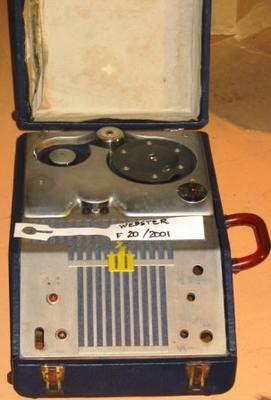Wire Recorder [Webster-Chicago]
Maker and role
Webster-Chicago Corporation, Manufacturer
Production date
Post 1947
See full details
Object detail
Accession number
F20.2001
Description
Webster Wire Recorder, similar to "80-1" type (red model). Case and lid vinyl on wood, blue. Deck cast aluminium silver (dull). Grill cloth blue. Red plastic handle. Tape recording mechanism on top of machine. Switch for playback. Dial on right reads minutes. Number of holes for missing components on face plate some labelled. Speaker and power plug at back.
Brief History
Wire recorders magnetically encoded data onto a thin steel wire and were the precursor technology to magnetic tape recording. The American company Webster-Chicago was a major producer of wire recorders after the Second World War. However the technology behind these devices is much older dating back to 1898 when Danish engineer Valdemar Poulsen invented the first wire recording device known as the Telegraphone.
The Webster-Chicago model 80-1 wire recorder was released around 1947. Webster-Chicago commonly marketed their devices as an electronic memory for the home. The microphone allowed users to record their own voices, music, and other sounds that the user would like to recall later. The device can record and playback audio that is magnetically encoded onto a thin steel wire. The 80-1 came mounted in its own carry case with removable lid. The lid contains storage for the microphone, power cable, and three wire spools. This device requires an AC 105-120V power supply to operate and is therefore incompatible with New Zealand’s mains power without an appropriate converter.
The Webster-Chicago model 80-1 wire recorder was released around 1947. Webster-Chicago commonly marketed their devices as an electronic memory for the home. The microphone allowed users to record their own voices, music, and other sounds that the user would like to recall later. The device can record and playback audio that is magnetically encoded onto a thin steel wire. The 80-1 came mounted in its own carry case with removable lid. The lid contains storage for the microphone, power cable, and three wire spools. This device requires an AC 105-120V power supply to operate and is therefore incompatible with New Zealand’s mains power without an appropriate converter.
Media/Materials
Credit Line
Webster-Chicago Corporation. Post 1947. Wire Recorder [Webster-Chicago], F20.2001. The Museum of Transport and Technology (MOTAT).


Public comments
Be the first to comment on this object record.